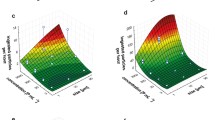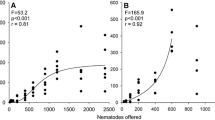Abstract
Identifying and understanding factors that affect interpretation of sediment toxicity is critical to the development and standardization of sediment test methods. In this study, we evaluated the influence of sediment particle size on survival, growth, emergence, and reproduction in a life cycle test with the midge Chironomus tentans, and on substrate selection behaviour of C. tentans larvae. In the life cycle assessment, larval development was followed for one generation on six substrates with mean particle sizes of 8, 146, 218, 306, 448, and 592 μm. For behavioural tests, first and third instar larvae were provided with a choice between paired substrates, with and without equal quantities of food. Survival of larvae at 20 d was not affected by particle size; however, survival of larvae at test completion was significantly reduced (65.6%) in the 8 μm substrate. Larval growth was not systematically related to particle size. Total emergence was significantly lower in the 8 and 592 μm substrates (50 and 53.1%, respectively) relative to the other substrates, reflecting the lower survival in these treatments. In addition, time to first emergence was significantly longer, and the rate of emergence depressed, in the 8 μm treatment. Reproductive output (mean eggs/female) was not significantly different among substrates, although fewer egg masses were produced in the 592 and 8 μm substrates. In behavioural tests, third instar larvae exhibited a weak preference for the smaller of two grain sizes when food was equally available, but this was not systematically related to the absolute difference in mean grain size. In contrast, first instar larvae consistently selected the smaller of two grain sizes when food was equally available; for these larvae, substrate selection was significantly correlated with the absolute difference in mean grain size. When food supply differed between substrates, a significantly higher proportion of both first and third instar larvae selected the substrate with food, independent of particle size. Together, the life cycle and behavioural data from this study suggest that sediment particle size, by itself, should not significantly influence interpretation of the results of toxicity tests with C. tentans.
Similar content being viewed by others
References
Ankley, G. T., D. A. Benoit, R. A. Hoke, E. N. Leonard, C. W. West, G. L. Phipps, V. R. Mattson & L. A. Anderson, 1993. Development and evaluation of test methods for benthic invertebrates in sediments: effects of flow rate and feeding on water quality and exposure conditions. Arch. Envir. Contam. Toxicol. 25: 12–19.
Ankley, G. T., D. A. Benoit, J. C. Balogh, T. B. Reynoldson, K. E. Day & R. A. Hoke, 1994. Evaluation of potential confounding factors in sediment toxicity tests with three freshwater benthic invertebrates. Envir. Toxicol. Chem. 13: 627–635.
Baker, J. H. & L. A. Bradnam, 1976. The role of bacteria in the nutrition of aquatic detritivores. Oecologia 24: 95–104.
Baker, R. L. & S. L. Ball, 1995. Microhabitat selection by larval Chironomus tentans (Diptera: Chironomidae): Effects of predators, food, cover, and light. Freshwat. Biol. 34: 101–106.
Benoit, D. A., G. A. Phipps & G. T. Ankley, 1993. A sediment intermittent renewal system for the automated renewal of overlying water in toxicity tests with contaminated sediments. Wat. Res. 27: 1403–1412.
Benoit, D. A., P. K. Sibley, J. J. Jeunemann & G. T. Ankley, 1997. Design and evaluation of a life cycle test with the midge Chironomus tentans for use in assessing chronic toxicity of contaminated sediments. Envir. Toxicol. Chem. 16: (In Press).
Davies, R. B., 1974. The planktonic activity of larval Chironomidae in Loch Levan, Kinross. Proc. r. Soc. Endinburg. B. 74: 275–283.
Davies, R. B., 1976. A trap for capturing planktonic chironomid larvae. Freshwat. Biol. 6: 373–380.
Day, K. E., R. S. Kirby & T. B. Reynoldson, 1993. Sexual dimorphismin Chironomus riparius (Meigen): Impact on interpretation of growth in whole-sediment toxicity tests. Envir. Toxicol. Chem. 13: 35–39.
DeWitt, T. H., G. R. Ditsworth & R. C. Swartz, 1988. Effects of natural sediment features on the phoxocephalid amphipod, Rhepoxynius abronius: Implications for sediment toxicity bioassays. Mar. Envir. Res. 25: 99–124.
DeWitt, T. H., J. O. Lamberson, & R. C. Swartz, 1989. Measuring the acute toxicity of estuarine sediments. Envir. Toxicol. Chem. 8: 1035–1048.
Hall, D. J., W. E. Cooper & E. E. Werner, 1970. An experimental approach to the production dynamics and structure of freshwater animal communities. Limnol. Oceanogr. 15: 839–928.
Ingersoll, C. G., G. T. Ankley, D. A. Benoit, E. L. Brunson, G. A. Burton, F. J. Dwyer, R. A. Hoke, P. F. Landrum, T. J. Norberg-King & P. V. Winger, 1995. Toxicity and bioaccumulation of sediment-associated contaminants using freshwater invertebrates: A review of methods and applications. Envir. Toxicol. Chem. 14: 1885–1894.
Keddy, C. J., J. C. Greene & M. A. Bonnell, 1995. Review of whole-organism bioassays: Soil, freshwater sediment, and freshwater assessment in Canada. Ecotoxicol. Envir. Safety 30: 221–251.
Lamberson, J. O., T. H. DeWitt & R. C. Swartz, 1992. Assessment of sediment toxicity to marine benthos. In G. A. Burton (ed.), Sediment Toxicity Assessment, Lewis Publishers, Boca Raton: 183–211.
Macchiusi, F. & R. L. Baker, 1992. Effects of predators and food availability on activity and growth of Chironomus tentans (Chironomidae: Diptera). Freshwat. Biol. 28: 207–216.
Mattson, D. E., 1981. Statistics. Difficult Concepts, Understandable Explanations. The C.V. Mosby Company, Toronto.
Mayer, L. M., S. A. Macko & L. Cammen, 1988. Provenance, concentrations and nature of sedimentary organic nitrogen in the Gulf of Maine. Mar. Chem. 25: 291–304.
McLachlan, A. J., 1969. Substrate preference and invasion behaviour exhibited by larvae of Nilodorum brevibuca Freeman (Chironomidae) under experimental conditions. Hydrobiologia 33: 237–248.
McLachlan, A. J. & C. H. Dickinson, 1977. Microorganisms as a factor in the distribution of Chironomus lugubris Zetterstedt in a bog lake. Arch. Hydrobiol. 80: 133–146.
McMurtry, M. J., D. J. Rapport, & K. E. Chua, 1983. Substrate selection by tubificid oligochaetes. Can. J. Fish. aquat. Sci. 40: 1639–1646.
Ohgaki, M., 1942. On the behaviour of nest-building habit of Chironomus larvae. Zool. Magazine Tokyo 54: 375–386.
Oliver, D. R., 1971. Life history of Chironomidae. Ann. Rev. Ent. 16: 211–230.
Power, E. A. & P. M. Chapman, 1992 Assessing sediment quality. In G. A. Burton (ed.), Sediment Toxicity Assessment, Lewis Publishers, Boca Raton: 1–18.
Phillips, N. W., 1984. Role of different microbes and substrates as potential suppliers of specific, essential nutrients to marine detritivores. Bull. Mar. Sci. 35: 283–298.
Reynoldson, T. B., K. E. Day, C. Klarke & D. Milani, 1994. Effect of indigenous animals on chronic endpoints in freshwater sediment toxicity tests. Envir. Toxicol. Chem. 13: 973–977.
Sibley, P. K., P. D. Monson & G. T. Ankley, 1997. The effect of gut contents on dry weight estimates of Chironomus tentans Larvae: Implications for interpreting toxicity in freshwater sediment toxicity tests. Envir. Toxicol. Chem. 16: 1721–1726.
Sokal, R. R. & F. J. Rohlf, 1969. Biometry. W. H. Freeman and Company, New York.
Suedel, B. C. & J. H. Rodgers, Jr., 1994. Development of formulated reference sediments for freshwater and estuarine sediment testing. Envir. Toxicol. Chem. 13: 1163–1175.
Suedel, B. C. & J. H. Rodgers, Jr., 1994. Responses of Hyalella azteca and Chironomus tentans to particlesize distribution and organic matter content of formulated and natural freshwater sediments. Envir. Toxicol. Chem. 13: 1639–1648.
Topping, M. S., 1971. Ecology of larvae of Chironomus tentans (Diptera: Chironomidae) in saline lakes in central British Columbia. Can. Ent. 103: 328–338.
Traunspurger, W. & C. Drews, 1996. Toxicity analysis of freshwater and marine sediments with meio-and macrobenthic organisms: A review. Hydrobiologia 328: 215–261.
United States Environmental Protection Agency, 1994. Methods for measuring the toxicity and bioaccumulation of sediment-associated contaminants with freshwater invertebrates. EPA/600/R94/024. Technical Report, Washington, D.C. 133 pp.
Vodopich, D. S. & B. C. Cowell, 1984. Interaction of factors governing the distribution of a predatory aquatic insect. Ecology 65: 39–52.
Watling, L., 1991, The sedimentary milieu and its consequences for resident organisms. Am. Zool. 31: 789–796.
Wiley, M. J., 1981. An analysis of some factors influencing the successful penetration of sediment by chironomid larvae. Oikos 36: 296–302.
Winnel, M. H. & D. J. Jude, 1984. Benthic community structure and composition among rocky habitats in the great lakes and Keuka Lake, New York. J. Great Lakes Res. 13: 3–17.
Author information
Authors and Affiliations
Rights and permissions
About this article
Cite this article
Sibley, P.K., Benoit, D.A. & Ankley, G.T. Life cycle and behavioural assessments of the influence of substrate particle size on Chironomus tentans (Diptera: Chironomidae) in laboratory assays. Hydrobiologia 361, 1–9 (1997). https://doi.org/10.1023/A:1003159323259
Issue Date:
DOI: https://doi.org/10.1023/A:1003159323259




